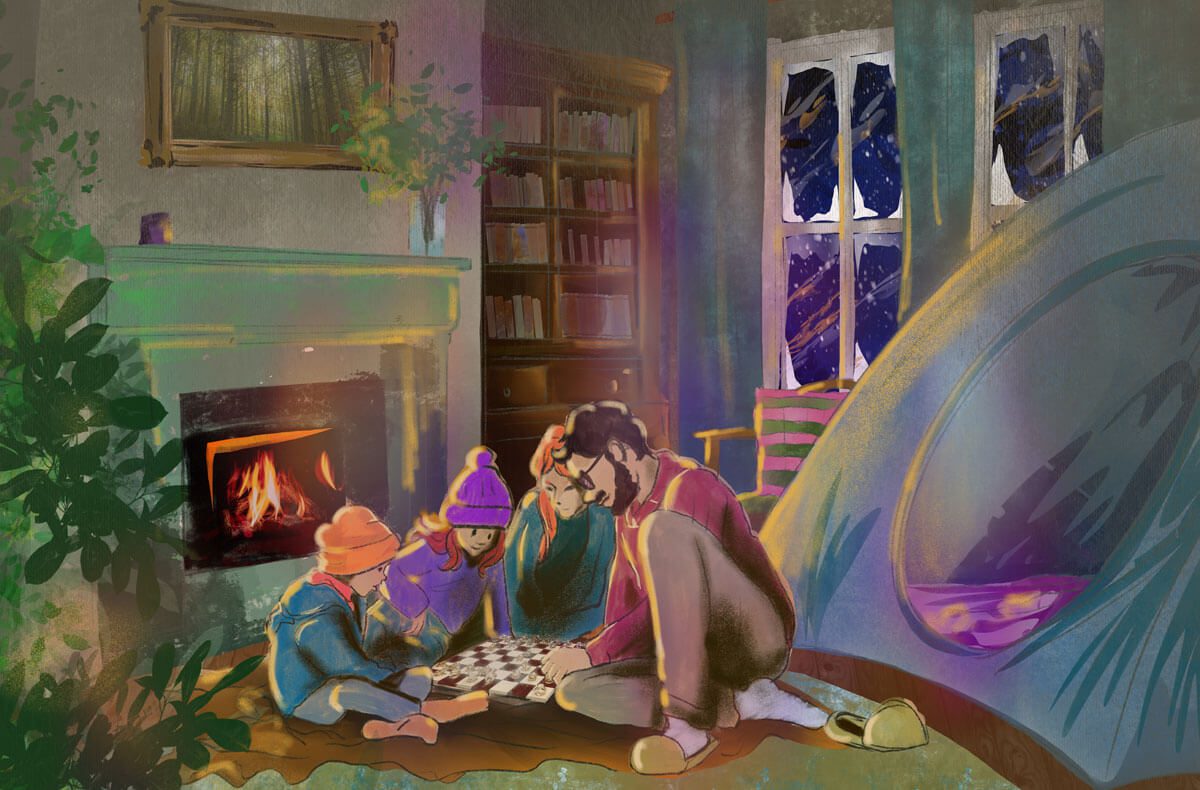
Illustration by Juliana Lagerstedt
Spring has officially started, but severe icy weather continues to impact millions around the country, while some areas are still recovering from recent winter storms.
I look back in gratitude that camping in Alaska prepared me for Central Texas winters. I worked as a naturalist in Alaska (among other places) for over a decade; I followed the humpback whale migration up to Southeast Alaska in 2001 and fell in love with the state.
I love to camp, and sleeping outside in Alaskan summers meant I needed a lot of gear, whether I was near Juneau’s temperate rainforests, or taking extended trips outside of Anchorage. I have a sleeping bag that can keep me warm when the temperature is freezing. I have a seemingly endless supply of thermal shirts, leggings, gloves, and warm socks.
Sadly, I haven’t been to Alaska in ten years, but I am increasingly using this gear to keep me warm during winter in Austin, Texas—inside my home.
Texans have found themselves in precarious situations due to cold weather and fragile infrastructure for the past few winters. Texans went through a terrible winter storm in 2021, and it was a repeat in February 2022.
Once the weather was forecasted to be cold, icy, and dangerous, many Texans began to prepare for the storm by stocking up on supplies, charging electronic devices, and wrapping up their pipes. This is what we are advised to do.
What most of us aren’t prepared to do is camp inside our homes.
During 2021’s Winter Storm Uri, also referred to as “Snovid” and “Snowpocalypse,” power was out for days and temperatures remained at or below freezing for over a week. Texans died in their homes due to cold exposure.
People tried to find other sources of warmth—some sat inside their running cars with the heat turned on; many did this inside their garages. Others lit fires inside their homes and some brought portable generators inside. These desperate acts lead to many hospitalizations, injuries, and death due to carbon monoxide poisoning.
During the storm in 2021, many went without power and water for days. Many were then displaced from our homes due to burst pipes and subsequent damage that made the houses unlivable.
The February 2023 storm had many thankful that it seemed to be less severe than February 2021. It was different, but not in a good way.
On the first day of the storm, there was rain and freezing temperatures; as the temperature hovered at freezing, the ice coating thousands of trees did not melt. A lot of tree branches started snapping; the weight of the ice being too much for the limbs to handle. It was eerie to hear branches crashing down to the ground; those falling trees hit a lot of power lines, causing more than 30% of households in Austin to lose power for days.
Many were not used to, or prepared to be in a situation without power or running water for extended periods of time. Although campers look forward to going without these luxuries to spend time in nature, no one really looks forward to a forced camping excursion due to infrastructure failure.
Items in a “normal” emergency preparedness kit are certainly useful during power failures. Batteries, clean water (either purchased or captured in anticipation of a storm), flashlights—all of these items came in handy as people waited for infrastructure systems to be restored.
But so far this decade, my camping gear is much better suited for these emergencies.
When you are on a multi-day hiking and camping trip, you carry your shelter, sleeping bag, clothes, all the food, water, and power supply (batteries, solar charges) that you will need for the trip. With the exception of the tent, all of these items are now part of my Central Texas Winter Storm kit.
I love camping in Texas, too, and one of my favorite places to spend time is the coast. This is when my Texas camping gear gets to shine—ridiculously insulated coolers that can keep food frozen or cold for days at time. These coolers are useful during long power outages. They’ve kept hundreds of dollars worth of food from spoiling. During the most recent storm, I lent one to a friend to store her insulin at the right temperature.
To be sure, having shelter during a Texas storm is still a privilege. I remember my grandmother, who was concerned about my love of camping, once asking me, “Why would you choose to sleep on the ground?”
Everything I’ve experienced during these storms has been a prolonged inconvenience, and pale in comparison to the population experiencing homelessness. Cold temperatures can be life-threatening for someone without housing, and dysfunctional infrastructure can impact the resources needed to support them, such as emergency shelters and emergency care.
It’s time to rethink what emergency preparedness means when the crisis isn’t just the weather, it’s also the potential impact storms can have on fragile infrastructure. Emergency preparedness kits should now include everything you need to camp for days—inside your home.
Policy makers, elected officials, administrators, individuals and funders need to address the impact of climate change and these changing weather events so they are not catastrophic.
Yes, infrastructure needs to be updated, but it won’t do much to blame systems for all the problems. People need to be prepared.
Building a camping arsenal for indoor emergencies is something now that people of privilege can do, but it is something that every person must be able to do to survive every season of the year. Because severe weather always arrives.

